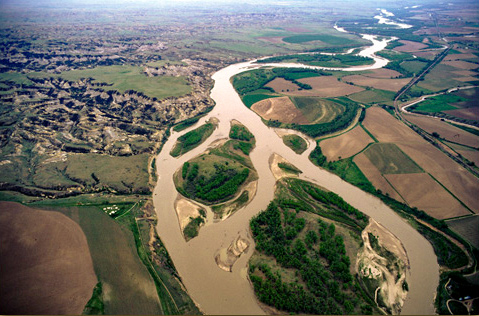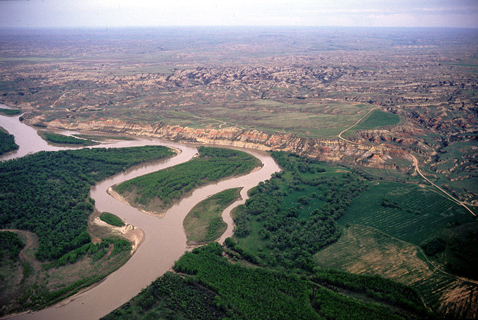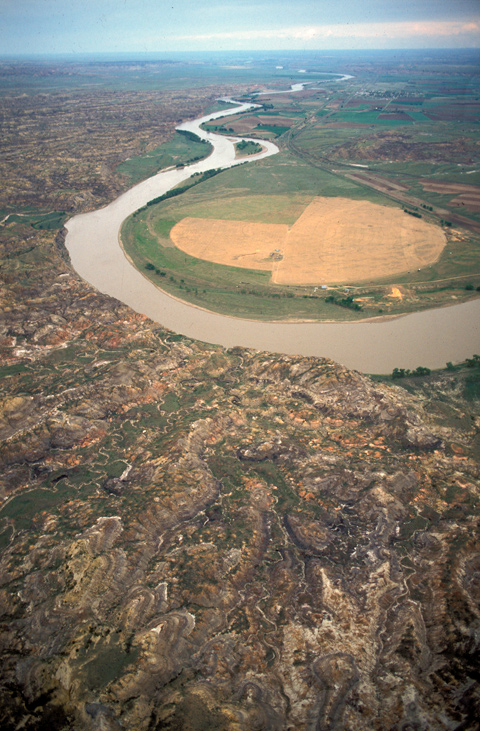The Powder River
François-Antoine Larocque might have threaded his way through the breaks and high prairies at the viewer’s left.
On 30 July 1806 Clark and his party camped near the mouth of the War har sah, or Powder River. He summarized the Yellowstone’s attractions, directing most of his attention toward opportunities for immediate expansion of the fur trade. “Like all other branches of the missouri which penetrate the Rocky Mountains, all that portion of it lying within those mountains abound in fine beaver and Otter.” The main advantage of the Yellowstone as a trade route was that it lay well south of the Missouri River and the homelands of the Blackfoot and their allies, the Atsinas, who together constituted the greatest threat to commercial enterprise, at least in Clark’s view.
“To an establishment on this river at Clarks Fork [of the Yellowstone], the Shoshones both within and West of the Rocky Mountains would willingly resort for the purposes of trade,” Clark concluded.
I have no doubt but the same regard to personal safety would also induce many numerous nations inhabiting the Columbia and Lewis’s river West of the mountains to visit this establishment in preference to that at the entrance of Maria’s river, particularly during the first years of those Western establishments. . . . It may therefore be looked to as one of the most important establishments of the western fur trade.
Fort Union Possibility
The only other reasonable alternative was to build on the eastern fringe of the hostile territory, opposite the mouth of the Yellowstone. In fact, even before the captains saw it, they were convinced of that. Lewis wrote, at Fort Mandan:
In point of position, we have no hesitation in declaring our belief, of it’s being one of the most eligible and necessary, that can be chosen on the Missouri, as well in a governmental point of view, as that of affording to our citizens the benefit of a most lucrative fur trade. This establishment might be made to hold in check the views of the British N. West Company on the fur-trade of the upper part of the Missouri, which we believe it is in their intention to panopolize[1]Panopolize. Lewis probably meant monopolize—literally, “one seller”—but he evidently had a feel for Latin, for his word—”all seller”—works well enough, even though it … Continue reading if in their power.
Fort Union would be established on the eastern fringe of that region, opposite the mouth of the Yellowstone, in 1829,[2]Erwin N. Thompson, Fort Union Trading Post: Fur Trade Empire on the Upper Missouri (Williston, ND: Fort Union Association, 1994). and another 21 years would pass before the trading post called Fort Benton would be founded, in 1850, at the head of navigation on the Missouri.
Meanwhile, the rest of the Yellowstone River beckoned. Even as Clark descended it, Manuel Lisa, back in St. Louis, was thinking of making an ascent, and in 1807 would build the first trading post on the Yellowstone—at the mouth of the Bighorn, not the Clark’s Fork.[3]Richard Oglesby, Manuel Lisa and the Opening of the Missouri Fur Trade (Norman: University of Oklahoma Press, 1963).
Lewis and Clark got more from the Mandans and Hidatsa than basic directions and lists of landmarks. Whether through certain questions the captains asked, or just from the tone of voice with which the Indians poke of the land they knew, or else out of that sincere congeniality that prompts people to share their feelings with welcome guests, the explorers gained a sense of the quality and beauty of the Yellowstone Valley. “If Indian information can be relied on,” wrote Lewis, “this river waters one of the fairest portions of Louisiana.”[4]Moulton, ed., Journals, 3:363–65.
Yellowstone Badlands
On 31 July 1806, eager to reunite with Lewis and his men, Clark’s contingent covered, by his estimate, sixty-six miles. In too much of a hurry to climb up and look around, he saw only the ragged river edge of the dramatic Yellowstone Badlands. He remarked:
“Those hills appear to be composed of various Coloured earth and Coal without much rock . . . . This high Country is washed into Curious formed mounds & hills and is cut much with reveens.
Around midday he passed the mouth of a tributary “40 yards wid Shallow and muddy,” and identified it as the stream the Mandan chief Sheheke (Big White) had called Oak-tar-pon-er. Years later it came to be called O’Fallon Creek, reportedly after Clark’s nephew, Benjamin O’Fallon, who served as a federal Indian agent until the 1820s.
Today agriculture thrives in the river bottoms and on the north side, and ranchers graze cattle among the “Curious formed mounts & hills” to the south.
That night, Clark complained of being “much disturbed last night by the noise of the buffalow which were about me.” A herd forded the river near his camp, causing him concern that the big bovines might trample on their canoes, “Splitting them to pieces.”
Navigation
Even though he didn’t show their locations on his 1814 map, which circulated with the Journals, he did describe them in his entry for 30 July 1806.[5]The Journals of the Expedition under the command of Capts. Lewis and Clark to the sources of the Missouri, thence across the Rocky Mountains, and down the river Columbia to the Pacific Ocean, … Continue reading Buffalo Shoals, so-called from the presence of one of those animals in them when he passed through, is:
a succession of bad shoals, interspersed with a hard, dark brown, gritty rock, extending for six miles, the last of which stretches nearly across the river, and has a descent of about three feet. At this place they were obliged to let the canoes down with the hand, for fear of their splitting on a concealed rock; though when the shoals are known a large canoe could with safety pass through the worst of them. This is the most difficult part of the whole Yellowstone river.
He continued:
Twenty miles from those shoals is a rapid, caused by a number of rocks strewed over the river; but though the waves are high, there is a very good channel on the left, which renders the passage secure. There was a bear standing on one of these rocks, which occasioned the name of the Bear Rapid.
Ten miles farther downstream is Wolf Rapid which he mentioned in his daily journals—”not bad,” he remarked—but was not included by Nicholas Biddle.
Sixty years later, Alfred E. Mathews appended to his remarks on the “Exit of the Yellowstone from the Mountains” a long, unsigned editorial from the Butte, Montana Territory, newspaper.[6]A. E. Mathews, Pencil Sketches of Montana. (Published by the Author, New York, 1868), 76–79. From the chronological center of the steamboat era, when the U. S. Army Corps of Engineers was just getting into high gear for remodeling rivers to enhance navigability, the writer voiced some reservations about the Yellowstone River as a freightway:
We think the Yellowstone might be navigated to the foot of Wolf Rapids, one hundred and fifty miles above its mouth. These Rapids are probably more dangerous than any other in the river, but in less than a hundred miles above them are Bear Rapids, which are very shallow and filled with large rocks—forty or fifty miles above them are Buffalo Shoals, where for more than six miles the river is very rapid, and ordinarily less than two feet in depth. The bottom is composed of yellow sandstone which is very hard, and crosses the river at this point in the ledge. It would be impossible to improve it. All thoughts of ascending the river by steam to the Big Horn must be given up.
“The best improvement that could be made,” the writer concluded, “would be a wagon road along the bank, from the foot of Wolf Rapids—a work that could be constructed without any serious difficulty.”
The “Old Yellowstone Trail” was not far in the future.
Notes
| ↑1 | Panopolize. Lewis probably meant monopolize—literally, “one seller”—but he evidently had a feel for Latin, for his word—”all seller”—works well enough, even though it has never become a “real” word. |
|---|---|
| ↑2 | Erwin N. Thompson, Fort Union Trading Post: Fur Trade Empire on the Upper Missouri (Williston, ND: Fort Union Association, 1994). |
| ↑3 | Richard Oglesby, Manuel Lisa and the Opening of the Missouri Fur Trade (Norman: University of Oklahoma Press, 1963). |
| ↑4 | Moulton, ed., Journals, 3:363–65. |
| ↑5 | The Journals of the Expedition under the command of Capts. Lewis and Clark to the sources of the Missouri, thence across the Rocky Mountains, and down the river Columbia to the Pacific Ocean, performed during the years 1804-5-6 by order of the Government of the United States Edited by Nicholas Biddle (2 vols.; 1814, New York: Heritage Press, 1962), II:520. |
| ↑6 | A. E. Mathews, Pencil Sketches of Montana. (Published by the Author, New York, 1868), 76–79. |
Experience the Lewis and Clark Trail
The Lewis and Clark Trail Experience—our sister site at lewisandclark.travel—connects the world to people and places on the Lewis and Clark Trail.
Discover More
- The Lewis and Clark Expedition: Day by Day by Gary E. Moulton (University of Nebraska Press, 2018). The story in prose, 14 May 1804–23 September 1806.
- The Lewis and Clark Journals: An American Epic of Discovery (abridged) by Gary E. Moulton (University of Nebraska Press, 2003). Selected journal excerpts, 14 May 1804–23 September 1806.
- The Lewis and Clark Journals. by Gary E. Moulton (University of Nebraska Press, 1983–2001). The complete story in 13 volumes.




